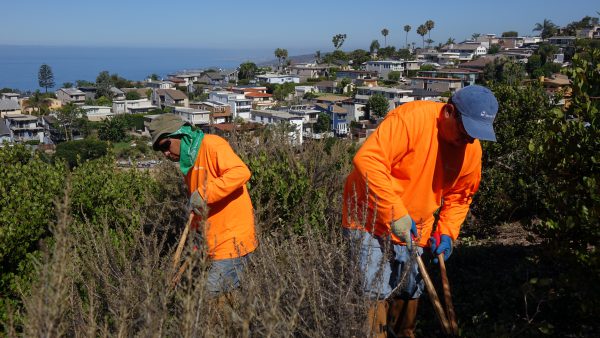
By Lou Ponsi, Special to the Independent
Fuel modification programs by Laguna Beach homeowners in very high fire hazard severity zones will now be considered by the community development director and fire marshal and no longer reviewed by the Design Review Board.
The Laguna Beach City Council on Tuesday voted unanimously to shift authority away from the Design Review Board to streamline the approval process while preserving landscape aesthetics and improving wildfire protections.
On the more controversial issue of amending the General Plan’s Landscape and Scenic Highways Element to expand required wildfire fuel modifications to the very high fire hazard severity zone, the Council voted unanimously to conduct a study examining the impacts of that proposed action.
The Fire Department proposed expanding fuel modification requirements for new construction and major remodels to comply with the state fire code. One rule up for consideration would ban keeping trees and shrubs at least 10 feet from structures.
Tuesday’s meeting is the latest clash of Laguna Beach residents conflicted over two controversial topics: the environmental benefits of maintaining an urban forest and hardening Laguna Beach for wind-blown fires that scorched Orange County’s foothills last year.
“I agree that we need more fire safety and mitigation but we need to do it right, councilmember George Weiss said.
The council’s actions came after dozens of comments from residents, followed by more than two hours of discussion by the five-member panel.
If the city expands the Very High Fire Hazard Severity Zone, homeowners could be required to trim back native and invasive brush around homes to provide firefighters with defensible space.
“The community has grown,” Mayor Bob Whalen said. “Laguna Beach, as beautiful as it is, has become overgrown. There comes a point where it gets too dense. We want to strike a balance. We want to very strongly move in a direction of better maintenance in town.”
Without fuel modification measures in place, homeowners may find it difficult to acquire insurance for their properties, Mayor Pro Tem Sue Kempf said.
“People are going to have an absolute fit if they don’t get insured,” Kempf said. “I think homeowners need to take responsibility with the fire safety around their house.”
Residents in support of expanding the very high fire hazard severity zone said it’s a matter of fire safety.
Resident Loren Carroll said the fire department has the best interest of the residents.
“I think it’s a very serious situation,” Carroll said of the city’s fire risk. “I think they are following the science.”
“I believe the code amendments will satisfy the need for fire safety and preserving the valuable landscape that all of us love,” said Sonny Myers, an Emergency and Disaster Preparedness Committee member.
Homeowners deep inside Laguna Beach neighborhoods should be just as concerned about Santa Ana wind-driven fires as those living next to wild open space, Mike Rohde, wildland fire defense and fuels manager for the Laguna Beach Fire Department, said in a phone interview. During the Camp Fire in Paradise, Calif. winds carried embers into the vents and attics of homes more than three miles from the fire.
“The inner-community defenses have to be just as strong as the woodland interface,” Rohde said.
In addition to fire-prone plants, firefighters see trellises and backyard structures catch fire and help blazes migrate into houses. When certain species of trees ignite, they can also produce extreme heat and suddenly drop limbs that can injure firefighters, Rohde said.
Some residents who are opposed to the revisions accused the Fire Department of fear-mongering. Others told the council that removing trees and vegetation would negatively impact aesthetics and endanger the habitats of certain wildlife.
In a letter to the council, resident Marion Staggs wrote that the fire department should not be permitted to dictate the types of foliage that exist on private property.
“I am shocked that this is occurring and I strongly oppose it,” Staggs wrote. “I believe in safety and also property rights.”
Resident John Ginger said, “This plan will completely change and ruin the character and charm of Laguna.”
On Jan. 20, the Planning Commission approved the amendments, in part, to ensure that Laguna Beach’s Landscape and Scenic Highways Element is consistent with related modifications made to the Municipal Code and reviewed by the commission in November.
“I don’t think we appreciate what these standards would do to existing homes,” resident Kevin Johnson said. “I think it needs to be aired more.”
The South Laguna Civic Association joined these residents in asking councilmembers for more modest changes to the Landscape and Scenic Highways Element that would preserve the mature trees.
“While there are some common-sense elements of the amendments that fit with a vision of a safer, more fire-ready Laguna Beach, the proposal aims to take a literal axe to one of Laguna
Beach’s greatest resources in the fight on climate change,” association president Greg O’Loughlin wrote in a letter. “It also dramatically uproots the character of our city and landscape, while offering no compelling strategy beyond a stark landscape of fire-bunkered properties.”
It’s been nearly two decades since Laguna Beach experienced major devastation from fires.
The 1993 Laguna fire ravaged more than 14,000 acres, destroyed close to 450 homes and forced the evacuation of 23,000 residents.
Fires in 2015 and 2018 burned acres of open space surrounding the city but left homes untouched.
Daniel Langhorne contributed reporting to this story.




